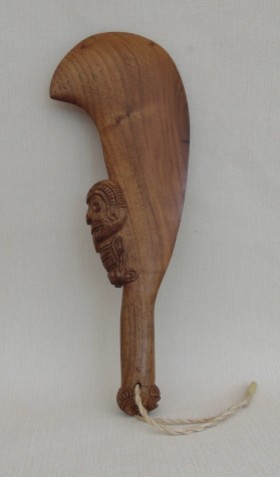This is a reasonable copy of a patu (Maori war club) but, in terms of the design brief that I set myself, it is an almost complete failure.
Let me explain. A couple of years ago, on a trip to New Zealand, I was lucky enough to have lunch with a Maori leader who was closely involved with the Maori Arts and Crafts Institute at Te Whakarewarewa, Rotorua. I came away with the utmost respect for the traditions and culture of the Maori people.
I resolved to attempt a Maori style carving using traditional methods. Since the Maori people had no knowledge of metal until the arrival of Europeans that meant that I had to make my own tools out of stone! I bought a few small pieces of New Zealand greenstone (a type of jade) and started to plan the project ready for my return.

I must make it clear that this was not a well researched academic project. Rather it was a personal attempt to explore the problems involved in using such basic tools and produce a souvenir of a wonderful holiday.
Clearly there would have to be compromises. Little did I know how many.
| Maori Technique | Compromise |
| Made of wood, whalebone or greenstone | Made of walnut (not native to NZ) |
| Stone tools shaped and honed on natural stones | Shaped and honed using wet & dry paper |
| Stone tools fixed to handle with resin from the kauri tree | Fixed to handle with epoxy resin |
| Weapon shaped and roughed out with a stone adze | Shaped and roughed out with a band saw & modern gouges |
| Detailed work on the figures done with stone chisels | Eventually gave up and used modern chisels |
| Hole drilled by hand with a stone tipped bit | Hole drilled with pillar drill |
I kept telling myself that I would use the stone tools for the detailed work but it proved beyond me. The problem was that although I could get a reasonable edge on the tool and make a good cut, as soon as there was any twist on the tool the edge chipped and it was back to the wet& dry. Stabbing cuts were OK but I was unable to achieve any of the flowing cuts that can be achieved with steel tools. The knife was very sharp and would cut through thick leather but again the edge was very prone to chipping.
I was disappointed that I was unable to complete the carving as planned but there was one element where I was able to use authentic Maori techniques. The cord was made from a single leaf of New Zealand flax (Phormium tenax). The flesh of the leaf was scraped off with a mussel shell and the exposed fibres divided into two and twisted into the cord that you see. Result!
So what does this say about those natives of New Zealand who lived in an essentially stone age culture hundreds of years ago? Respect!!
John Francklow




